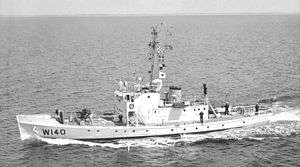USCGC General Greene (WPC-140)
 USCGC General Greene, 1962 | |
| History | |
|---|---|
| Name: | USCGC General Greene (WPC-140/WSC-140) |
| Namesake: | Nathanael Greene, American Revolutionary War general[1] |
| Builder: | American Brown Boveri Electric Corporation, Camden, New Jersey |
| Cost: | $90,000 USD[1][Note 1] |
| Launched: | 14 February 1927 |
| Commissioned: | 7 April 1927 |
| Decommissioned: | 15 November 1968 |
| Fate: | Sold, 1976 |
| General characteristics | |
| Type: | Patrol boat |
| Displacement: | 232 long tons (236 t) |
| Length: | 125 ft (38 m) |
| Beam: | 23 ft 6 in (7.16 m) |
| Draft: | 7 ft 6 in (2.29 m) |
| Propulsion: | 2 × 8-cylinder, 268A General Motors 850 hp late 50's to decommision300 hp (224 kW) engines |
| Speed: |
|
| Range: |
|
| Complement: | 3 officers, 17 men (1960) |
| Armament: |
|
USCGC General Greene (WPC/WSC/WMEC-140), was a 125 ft (38 m) United States Coast Guard Active-class patrol boat, in commission from 1927 to 1968 and the fourth cutter to bear the name of the famous Revolutionary War general, Nathanael Greene. She served during the Rum Patrol, World War II and into the 1960s performing defense, law enforcement, ice patrol, and search and rescue missions.[1]
Construction and commissioning
The General Greene was built by the American Brown Boveri Electric Corp. of Camden, New Jersey, at a cost of $90,000.[Note 2] She was launched on 14 February 1927, and commissioned on 7 April 1927.[1][4]
Patrol duties during the Depression
General Greene had been designed specifically for prohibition enforcement service and assumed Rum Patrol duty 15 May 1927 with a home-port of Boston, Massachusetts[4] Her routine consisted of picketing liquor laden "mother ships" and preventing them from offloading prohibited cargo to smaller contact boats that were used to deliver liquor to shore.[5] On 15 March 1931 she departed Boston bound for St. Johns, Newfoundland to join the International Ice Patrol for the first time. At the end of the patrol season she would return to Boston and resume Rum Patrol duties; this pattern would continue through the end of the 1933 Ice Patrol season.[4] With the end of prohibition in 1933, General Greene assumed a more traditional role of a Coast Guard cutter, that of search and rescue, law enforcement, merchant vessel inspection, and defense training.[Note 3][6] In 1941 she conducted an oceanographic survey off the coast of Newfoundland and while on the survey in May 1941, she was ordered to search for survivors from two British freighters torpedoed off the coast of Greenland. She recovered 39 survivors from the SS Marconi, and observed part of the Royal Navy task force engaging the German battleship Bismarck.[1]
World War II service
In early 1942 she was re-designated WSC-140, and assigned to search and rescue and convoy escort duties. On 25 May 1942 she engaged a German U-boat with depth charges in a dense fog off Nantucket Shoals while rescuing survivors from the British freighter SS Peisander.
Post-war service
In 1946 she returned to her station at Woods Hole, and from 1947 until her decommissioning in 1968, served out of Gloucester, Massachusetts.[1]
She was transferred to Newburyport, Massachusetts, for use as a museum ship, but was returned to the Coast Guard in 1976 and sold. In 1979, renamed Belmont, and under the flag of Guatemala, she was seized by the Coast Guard for drug smuggling.[1]
See also
Notes
- Footnotes
- Citations
- 1 2 3 4 5 6 7 "General Greene, 1927", Cutters, Craft & U.S. Coast Guard-Manned Army & Navy Vessels, U.S. Coast Guard Historian's Office
- 1 2 3 4 5 Scheina (1982), p 45
- ↑ Scheina (1990), p 58
- 1 2 3 "Record of Movements, Vessels of the United States Coast Guard, 1790–December 31, 1933", U.S. Coast Guard, Department of Transportation, p 428
- ↑ Johnson, p 80
- ↑ Canney, p xiii
- Websites
- "General Greene, 1927" (asp). Cutters, Craft & U.S. Coast Guard-Manned Army & Navy Vessels. U.S. Coast Guard Historian's Office. Retrieved 3 February 2014.
- "Record of Movements, Vessels of the United States Coast Guard, 1790–December 31, 1933" (pdf). U.S. Coast Guard, Department of Transportation. Retrieved 3 February 2014.
- References cited
- Canney, Donald L. (1995). U.S. Coast Guard and Revenue Cutters, 1790–1935. Naval Institute Press, Annapolis, Maryland. ISBN 978-1-55750-101-1.
- Johnson, Robert Irwin (1987). Guardians of the Sea, History of the United States Coast Guard, 1915 to the Present. Naval Institute Press, Annapolis, Maryland. ISBN 978-0-87021-720-3.
- Scheina, Robert L. (1982). U.S. Coast Guard Cutters & Craft of World War II. Naval Institute Press, Annapolis, Maryland. ISBN 978-0-87021-717-3.
- Scheina, Robert L. (1990). U.S. Coast Guard Cutters & Craft, 1946–1990. Naval Institute Press, Annapolis, Maryland. ISBN 978-0-87021-719-7.